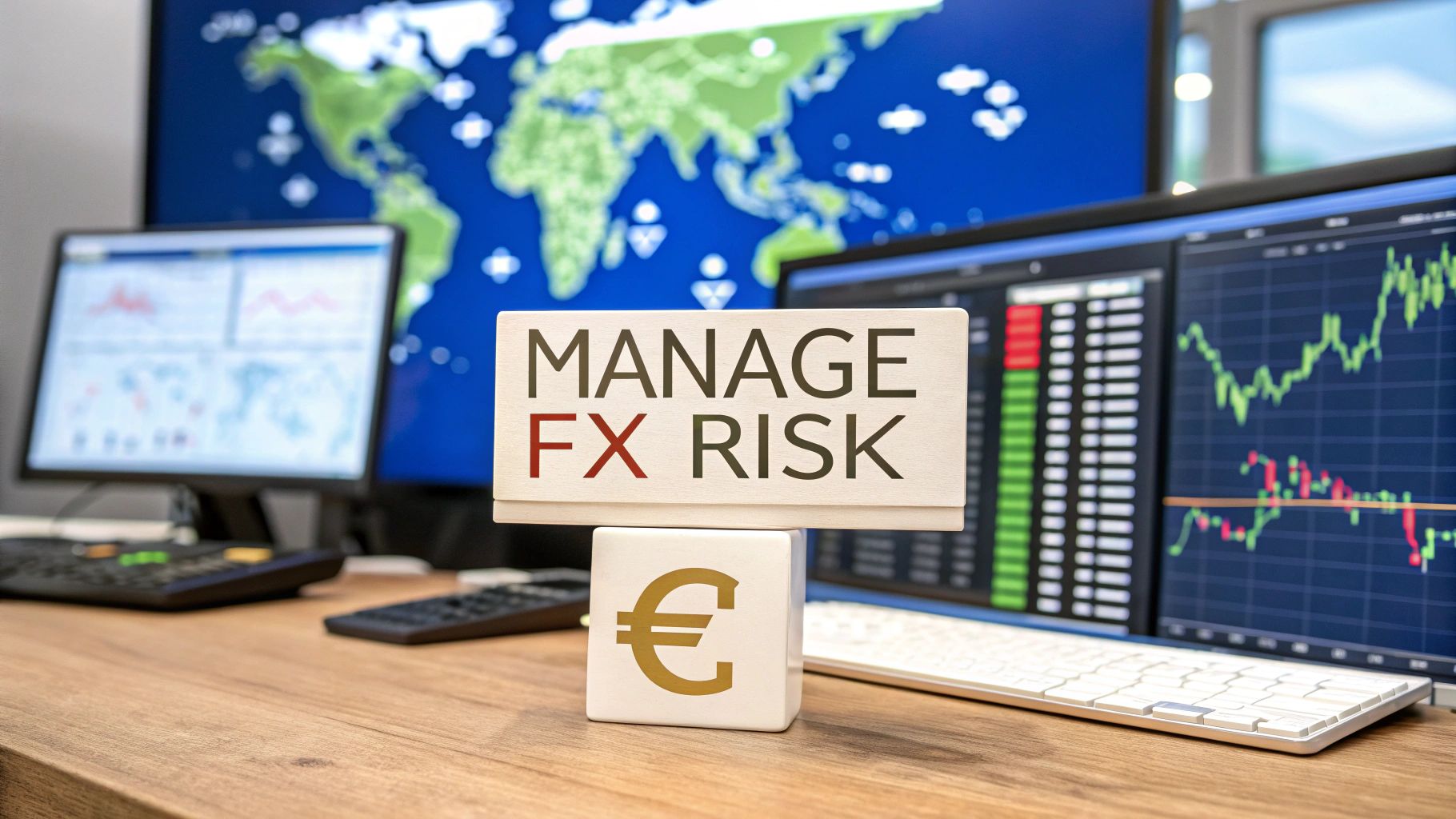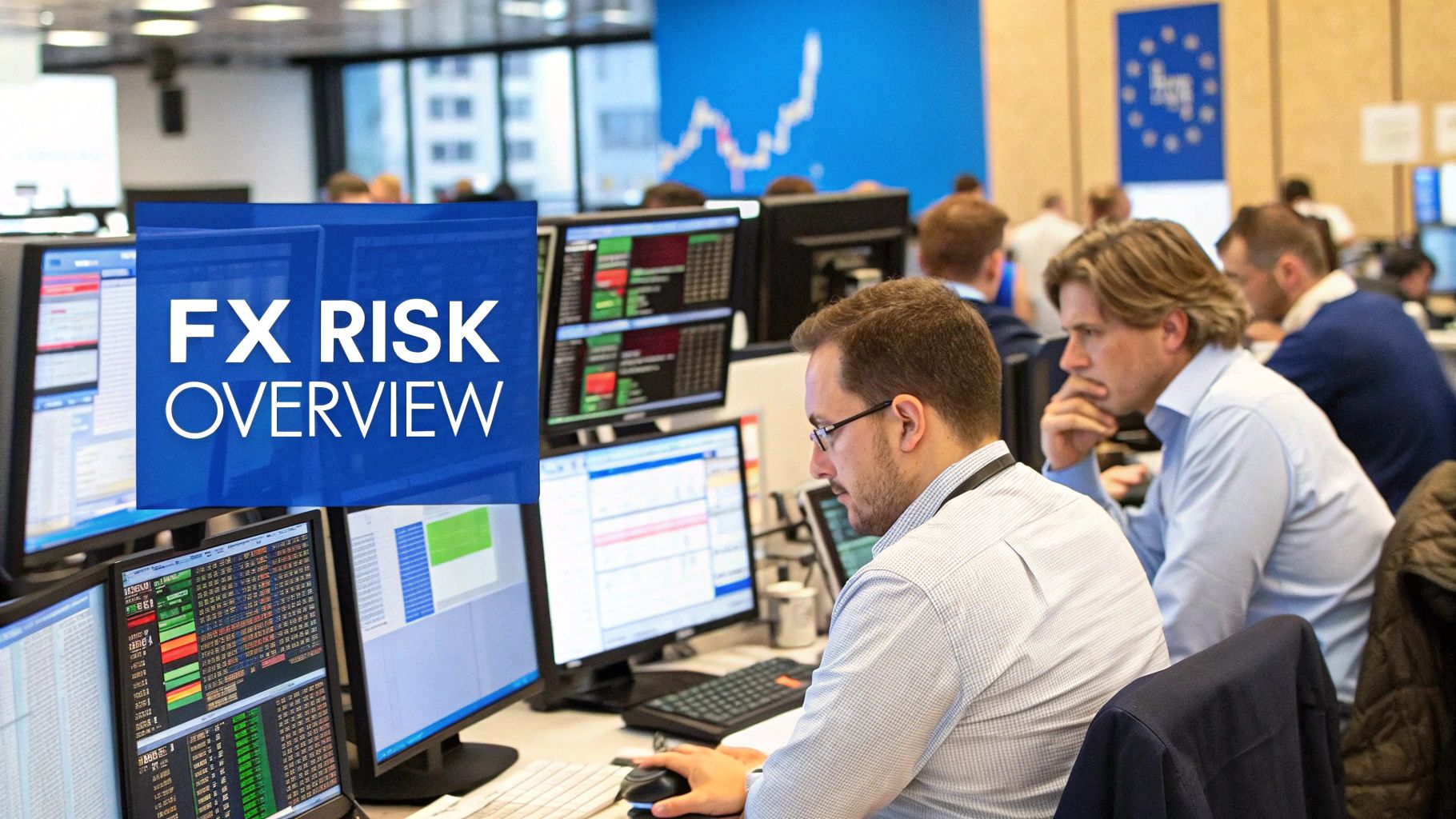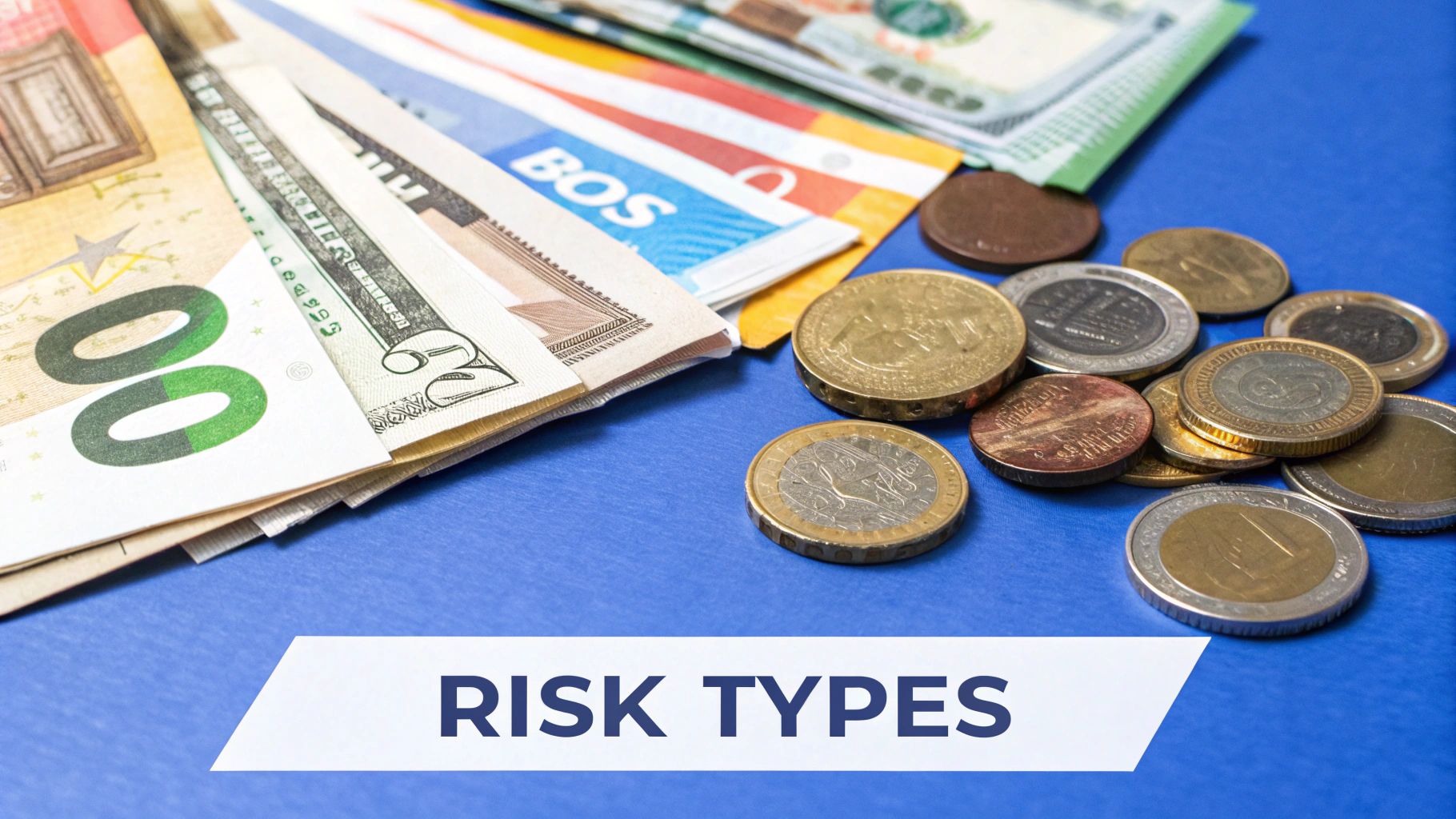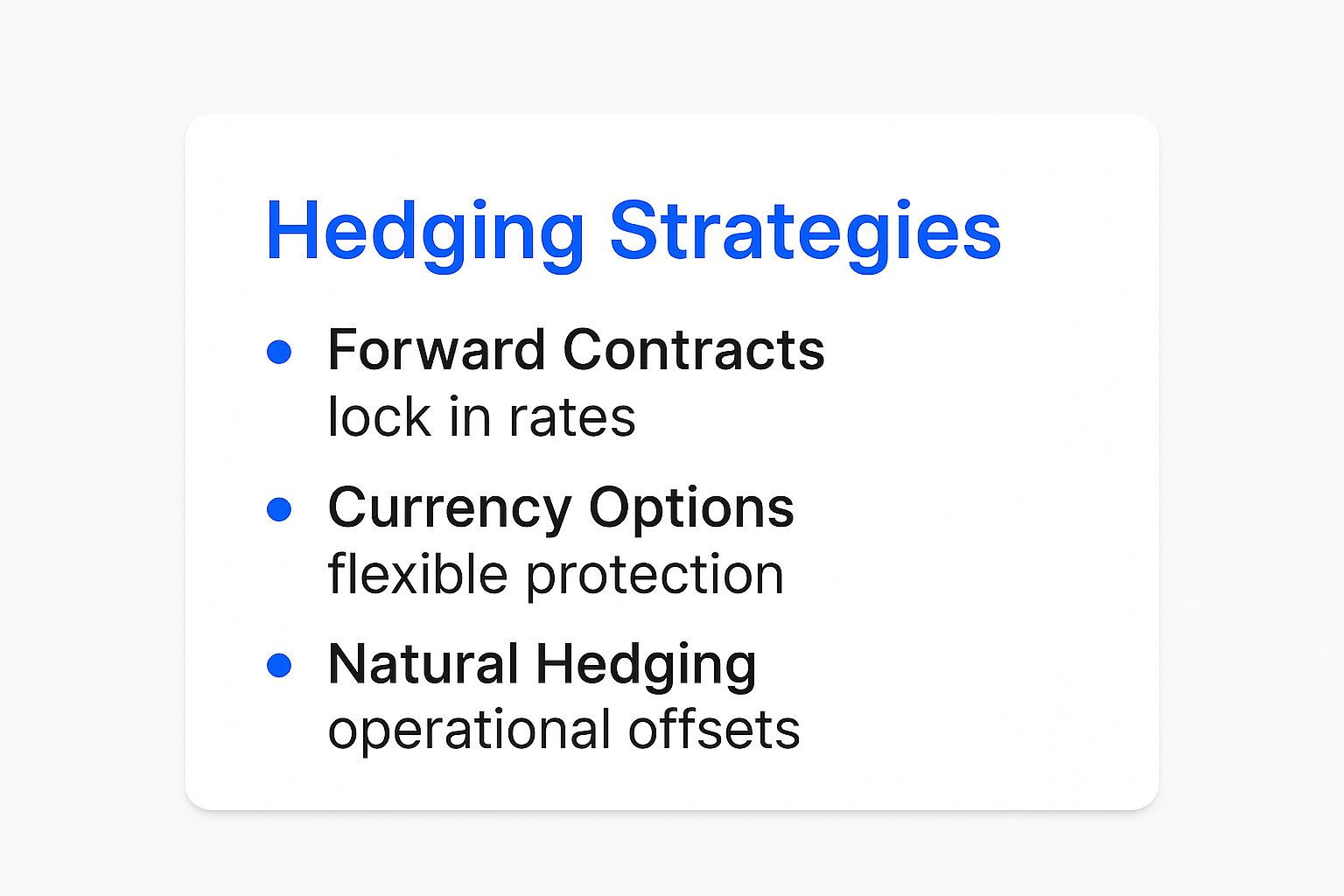Our Marketing Team at PopaDex
Managing Foreign Exchange Risk: Essential Strategies for Success

When you’re running a business that operates across borders, managing foreign exchange risk isn’t just a good idea—it’s essential. This isn’t about trying to outsmart the market or speculate on currency movements. It’s about building a financial shield to protect your profits and cash flow from the unpredictable swings of the global market. Think of it as creating financial certainty for your bottom line.
Why Currency Volatility Is a Threat to Your Bottom Line

Ignoring currency fluctuations is like playing a high-stakes game of chance with your company’s money. Even small, seemingly insignificant market shifts can quietly chip away at your profit margins on exports. They can also cause the cost of your imported goods to spike unexpectedly, creating serious instability on your balance sheet. This isn’t just a theoretical exercise; it’s a real, tangible threat to your financial stability.
Real-world events, like a sudden cross-currency loan crisis, are stark reminders of how quickly unhedged currency exposure can turn into major losses. A proactive risk management strategy is no longer a “nice-to-have”—it’s a core pillar of modern financial management.
The Three Faces of FX Exposure
To get a handle on this risk, you first need to know what you’re up against. Every international business deals with three distinct types of currency exposure, often all at once.
-
Transaction Risk: This is the one you’ll encounter most often. It’s the risk that pops up in the time between locking in a price in a foreign currency and actually settling the payment. If the exchange rate moves against you in that gap, what you actually pay or receive will be different from what you budgeted for.
-
Translation Risk: If your company has overseas subsidiaries, this one’s for you. When you consolidate all your financials, you have to “translate” the assets and liabilities from your foreign operations back into your home currency. An unfavorable rate change can make your international assets look less valuable on paper, directly impacting your balance sheet.
-
Economic Risk: This is the long-term, strategic beast. It’s about how unexpected currency movements can affect your company’s future cash flow and even its overall market value. It’s less about a single transaction and more about your fundamental competitive position in the global marketplace.
It’s a fact that global currency risk factors are a huge driver of these fluctuations. Recent analysis shows these global factors can account for anywhere between 25% to 80% of the movement in a currency’s return over time.
However, things are getting more complex. During periods of major uncertainty, like the recent pandemic or aggressive interest rate hikes, the influence of these global factors can fade. This means country-specific issues and central bank policies are playing a much bigger role, making the job of managing FX risk that much harder. You can dive deeper into these dynamics by checking out the Bank of Canada’s recent findings.
How to Identify and Measure Your FX Exposure
 You can’t manage a risk you can’t see. So, the very first step in building a solid FX risk strategy is to pinpoint exactly where your business is vulnerable to currency swings. This goes way beyond just glancing at your outstanding foreign-currency invoices.
You can’t manage a risk you can’t see. So, the very first step in building a solid FX risk strategy is to pinpoint exactly where your business is vulnerable to currency swings. This goes way beyond just glancing at your outstanding foreign-currency invoices.
True exposure often hides in plain sight. It might be buried in your international operating costs, like paying a remote team in euros. It could even be an indirect threat, like a competitor in a country whose currency just tanked, suddenly allowing them to slash their prices and steal your market share.
Uncovering Your Total FX Footprint
To get a real handle on this, you need to shift from a scattered, siloed view to a single, consolidated one. That means hunting down every single cash flow—both coming in and going out—that isn’t in your home currency. Think of it as creating a complete map of your company’s financial borders.
Start by making a comprehensive list of all your foreign currency activities. It’s an inventory of risk.
- Revenues: What sales are you making to international customers billed in their local currency (like EUR, GBP, or JPY)?
- Expenses: Are you paying overseas suppliers, international contractors, or for software subscriptions priced in a foreign currency?
- Assets: Do you hold bank accounts or investments in other currencies?
- Liabilities: What about loans or other financial obligations you owe in a foreign currency?
This detailed breakdown is the foundation of your entire exposure analysis. For most businesses, trying to do this manually in a spreadsheet is a recipe for disaster. This is where knowing how to implement proper multi-currency accounting becomes absolutely crucial for tracking these diverse flows accurately. Without a system to see everything in one place, you’re flying blind.
When you’re looking for practical tools, platforms offering specialized financial services can be a game-changer. It’s worth exploring your options; checking out something like the Fundpilot Pricing page can give you an idea of the solutions out there.
Quantifying the Risk
Once you’ve mapped out all your exposures, it’s time to measure them. This is where you turn that vague sense of worry into cold, hard data. The goal here is to calculate your net exposure for each and every currency you handle.
For each foreign currency, you just need to subtract your total expected outflows from your total expected inflows over a set period, like a quarter.
Net Exposure = (Foreign Currency Inflows) - (Foreign Currency Outflows)
A positive number means you have a net long position—you benefit if that foreign currency gets stronger. A negative number gives you a net short position, meaning you benefit if that currency weakens. This simple calculation tells you exactly where your financial neck is on the line.
Let’s say you’re expecting €50,000 from your German clients but have a €20,000 bill to pay a supplier in France. Your net exposure is +€30,000. This positive exposure means a rising euro is fantastic for your bottom line, but a falling euro will eat into your profits.
It’s this kind of clarity that lets you build a hedging strategy that actually works for your specific situation.
Choosing the Right Hedging Instruments for Your Business
Selecting the right tools to manage foreign exchange risk is a critical decision, and there’s no single “best” answer. The ideal instrument comes down to your business model, your appetite for risk, and the specific kind of currency exposure you’re facing. It’s really about striking a balance between locking in certainty and maintaining flexibility.
The most common hedging instruments fall into a few key categories, and each one serves a different purpose. Understanding these differences is the first step toward making a smart choice that protects your bottom line without tying up your capital unnecessarily.
Locking in Certainty with Forward Contracts
A forward contract is one of the most straightforward and popular hedging tools out there. It’s a simple agreement you make with a bank to exchange a specific amount of one currency for another on a future date, but—and this is the key part—at an exchange rate you agree on today.
Let’s walk through a real-world scenario. Imagine your U.S.-based e-commerce business owes a supplier in the UK £100,000 in three months. Instead of spending that time worrying about what the GBP/USD rate will do, you can enter a forward contract to lock in the rate now. Just like that, you’ve removed all the uncertainty. You know exactly what that payment will cost in U.S. dollars, making your cash flow forecasting solid and predictable.
The primary advantage here is the complete elimination of downside risk for that specific transaction. You have absolute cost certainty, which is invaluable for budgeting and protecting profit margins. However, this certainty comes at a price—you also give up any potential upside if the exchange rate moves in your favor.
Maintaining Flexibility with Currency Options
What if you need protection but don’t want to completely lose out on favorable currency moves? This is exactly where currency options come into play. An option gives you the right, but not the obligation, to buy or sell a currency at a set price on or before a future date.
Let’s say your European software firm just landed a major U.S. client and you’re expecting a payment of $500,000 in six months. You’re concerned the dollar might weaken against the euro, which would eat into your revenue. You could buy a currency option that allows you to sell those dollars for euros at a predetermined “strike price.”
Here’s how it could play out:
- If the dollar weakens: You exercise your option, selling your dollars at the better, pre-agreed rate. You’re protected.
- If the dollar strengthens: You simply let the option expire and convert your dollars on the open market at the more favorable spot rate. You win.
This flexibility isn’t free, of course. It comes at a cost known as the premium, which you pay upfront for the option. Think of it as an insurance policy against nasty rate movements.
Below is a quick comparison of the most common hedging tools to help you decide which might be right for your business.
Comparison of Common FX Hedging Instruments
| Hedging Tool | How It Works | Best For | Key Advantage | Key Disadvantage | | :— | :— | :— | :— | :— | | Forward Contract | Lock in a future exchange rate today for a specific transaction. | Businesses needing absolute cost certainty for known future payments or receipts. | Eliminates all downside currency risk completely. | You lose any potential upside if the exchange rate moves in your favor. | | Currency Option | Gives the right, but not the obligation, to exchange currency at a set rate. | Protecting against downside risk while retaining the ability to profit from favorable moves. | High flexibility; you only exercise it when it’s beneficial. | Requires paying an upfront premium, which is a sunk cost if the option isn’t used. | | Currency Swap | An agreement to exchange principal and/or interest payments in different currencies over time. | Companies with long-term foreign currency debt or revenue streams. | Manages long-term exposure and can be highly customized. | More complex to set up and manage than forwards or options. | | Natural Hedging | Structuring operations (e.g., matching revenues and costs in the same currency). | Businesses with significant, ongoing operations in foreign markets. | No direct financial cost; aligns the business model with currency realities. | Limited applicability; not all businesses can restructure their operations this way. |
Each of these instruments has a distinct role to play. While forwards offer straightforward protection, options provide valuable flexibility. More complex tools like swaps are better suited for long-term, structural risks, and natural hedging is the gold standard if your business operations allow for it.

These instruments are favored by large firms for a reason. Research shows that multinational corporations lean heavily on these derivatives to hedge against exchange rate risk. Over-the-counter currency forwards are the most popular tool by far, making up more than half of all hedging activity because they can be customized. Currency options account for about 20% of hedges, with currency swaps following at around 10%. This shows a clear preference for flexible, private agreements over standardized, exchange-traded products. You can dive into the details on how U.S. firms approach foreign exchange risk management in this IMF paper.
Crafting Your Foreign Exchange Risk Policy
Moving from late-night, reactive panic over currency swings to a calm, structured strategy is what separates the pros from the amateurs in international business. Once you’ve mapped out and measured your exposures, the next step is to get your game plan down on paper. It’s time to create a formal foreign exchange risk policy.
This doesn’t have to be some dense, 50-page legal manuscript that nobody reads. Honestly, a simple and clear policy is almost always more effective. Why? Because it gives your team a playbook they can actually follow, providing the discipline and guidance needed to turn FX management from a chaotic guessing game into a repeatable, systematic process.
Defining Your Risk Tolerance
First things first: you need to define your company’s risk tolerance. This is where you get brutally honest about how much financial uncertainty your business can actually handle. There’s no right or wrong answer here; it’s completely unique to your financial health, business model, and long-term goals.
Start by asking some tough questions to figure out your threshold:
- What would a 5% or 10% hit from a bad currency move do to our quarterly net income?
- At what dollar amount does a currency loss become “material” to our bottom line?
- Are we okay with some volatility for the chance of a currency-related gain, or is our number one goal just to protect our capital?
Getting clear answers to these questions draws a line in the sand. For example, a company might decide it will hedge any single exposure that could wipe more than $50,000 off its quarterly profits. Just like that, you have a concrete trigger for action.
Establishing Clear Hedging Objectives
With your risk tolerance locked in, you can now set crystal-clear objectives for your hedging program. This is where you state exactly what you’re trying to accomplish. Being explicit here is critical—it eliminates ambiguity and, most importantly, shuts down any temptation to start speculating.
Your hedging policy should exist for one reason: to reduce volatility and protect your budgeted exchange rates. It’s not for making a quick buck by betting on currency movements. That’s a completely different (and far riskier) game.
Your policy needs to state its purpose plainly. For instance: “The objective of our FX hedging program is to protect the budgeted USD value of our European sales revenue, with the goal of hedging 75% of forecasted sales each quarter.” This goal is specific, measurable, and tied directly to a business outcome. It keeps the entire team focused on protection, not speculation.
Authorizing Instruments and Assigning Roles
Finally, your policy has to get into the nitty-gritty of execution. This means spelling out which hedging instruments are approved for use. A typical starting policy might greenlight simple forward contracts because they’re straightforward and cost-effective, while restricting more complex tools like exotic options until the team builds up more experience.
Just as important is defining who does what. Who has the authority to execute trades with the bank? Who is on the hook for monitoring exposure levels and reporting on how the hedges are performing? Assigning clear ownership prevents confusion and makes sure everyone is accountable. This final piece of the puzzle transforms your FX risk strategy from an idea into a well-oiled, disciplined corporate function.
Global Perspectives on Hedging Strategies

Managing foreign exchange risk isn’t a simple science with a universal formula. It’s more of an art, deeply shaped by local markets, regulatory quirks, and even business culture. A strategy that’s a home run for a U.S. importer might be completely off the table for an exporter somewhere else in the world. Getting a handle on these differences is the first step to building a risk management plan that’s both robust and adaptable.
This global variation isn’t just an academic talking point. It has real, tangible effects on how businesses operate and shield themselves from currency swings. Think about a country’s economic engine—is it export-heavy or import-reliant? What’s the government’s stance on financial derivatives? These factors create entirely different hedging environments. If you ignore this context, you’re missing a huge piece of the risk puzzle.
Contrasting Approaches East and West
You can see this divergence play out perfectly when you compare how large firms in the United States and China tackle FX risk. Their playbooks are molded by completely different circumstances.
For U.S. firms, the go-to tool is often the forward contract. It’s a straightforward way to lock in a future exchange rate, giving businesses a clear, predictable cost. It’s direct, widely used, and gets the job done.
Chinese firms, on the other hand, frequently lean towards currency swaps. This preference is tied to their massive exposure from export activities, which makes them incredibly sensitive to currency movements. For a long time, however, strict government rules put a cap on how much they could use derivatives, causing many Chinese companies to hedge less than their American counterparts. A fascinating study of 84 large firms in each country really breaks down these differences in hedging effectiveness.
Interestingly, that same study found that despite their more cautious approach, Chinese firms often achieved higher hedging effectiveness. This could be because their conservative strategy helped them avoid the risks of over- or under-hedging—a common pitfall for many U.S. companies.
Why This Global View Matters
So, what’s the big takeaway from all this? There’s no single “best” way to hedge. Your strategy needs to be custom-fit not only to your company’s unique risk appetite but also to the realities of the markets you’re in. A winning approach demands a nuanced understanding of the international financial landscape.
Adopting this global perspective forces you to think critically about your own methods. It pushes you to ask how international trends and regional norms should inform your decisions, making sure your strategy is both effective and practical. This wider view is a fundamental part of sophisticated cross-border financial planning, helping you build a more resilient financial foundation for your global operations.
Common Questions on Managing FX Risk
Even with a solid strategy in place, you’re bound to run into questions when dealing with foreign exchange. It’s a complex area. Let’s tackle some of the most common ones we hear from businesses just like yours. Getting clear, practical answers can make all the difference.
At What Size Should My Business Start Actively Managing FX Risk?
Forget about looking for a magic revenue number. There isn’t one. The real trigger is when your foreign currency flows become a meaningful slice of your business. A good rule of thumb is when they hit 5-10% of your total revenue or expenses.
But even more important is the potential impact. Ask yourself this: if the exchange rate moved against you by just 5%, would it take a serious bite out of your quarterly profit? If the answer is yes, it’s time to build a formal strategy. This is less about your company’s size and more about how much exposure you can stomach before it hurts your bottom line.
Is It Possible to Completely Eliminate Foreign Exchange Risk?
In a word, no. Trying to eliminate every last shred of FX risk is not only impractical, but it’s usually a waste of money. The real purpose of a good hedging strategy isn’t to get to a zero-risk utopia. It’s about taming uncertainty and protecting your profit margins to a level you’re comfortable with.
Hedging has costs, whether they’re obvious or hidden. Insuring against every tiny possibility can easily cost more than the risk you’re trying to avoid in the first place. A smart policy is all about managing risk to create predictable cash flow and budget certainty.
How Often Should I Review My Foreign Exchange Risk Policy?
Your FX risk policy should be a living, breathing document—not something you create once and forget about. At a minimum, you should dust it off and review it once a year to make sure it still makes sense for your business.
That said, some events should trigger an immediate review, no matter when your annual check-in is scheduled. Think about things like:
- Entering a new international market and taking on a brand-new currency exposure.
- Making a major change to your supply chain, like switching to a supplier in another country.
- Seeing a dramatic and sustained spike in market volatility that completely changes the risk game.
Regular reviews keep your strategy sharp and aligned with what your business is doing right now, not what it was doing last year. If you have more questions, you can always dig deeper in a comprehensive FAQ section to get even more clarity.
Ready to gain a crystal-clear view of all your assets, including those in different currencies? PopaDex offers the tools to consolidate your entire financial portfolio in one place, helping you track your net worth and make informed decisions. Take control of your financial future today at https://popadex.com.